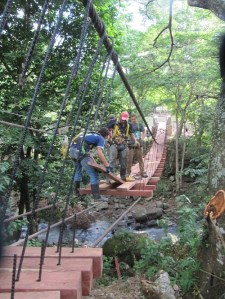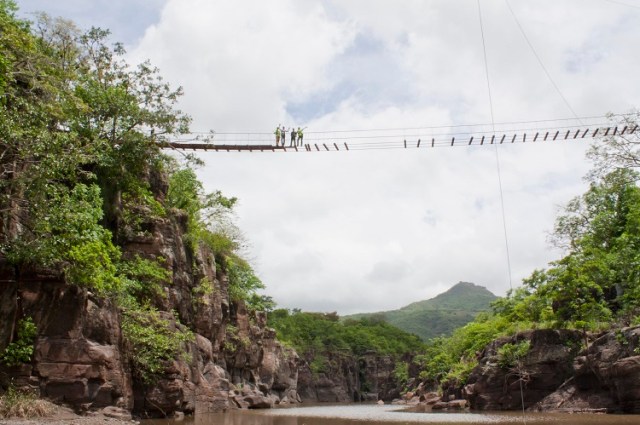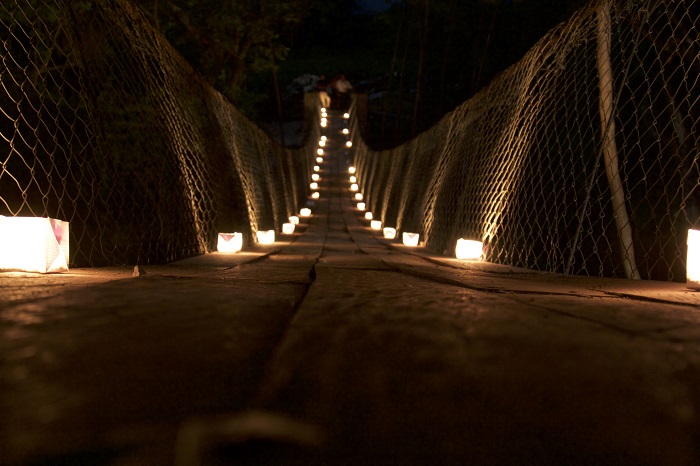BTN.com staff, November 14, 2015
In the United States, we take our transportation infrastructure for granted. It?s not necessarily a big deal for us to travel, say, a hundred miles from where we live, no matter where that might be. But in many parts of the world, a trip of just a few miles is fraught with hazards, as roads and bridges are either in poor condition or non-existent.
That means transporting food and medicine to those places - and allowing people to access schools and hospitals that aren?t close to where they live - can be problematic.
 That?s where Continental Crossings comes in. The University of Iowa chapter of the national Bridges to Prosperity program, which builds suspension bridges in rural communities, is an entirely student-run international development organization that wants to make these problems a thing of the past.
That?s where Continental Crossings comes in. The University of Iowa chapter of the national Bridges to Prosperity program, which builds suspension bridges in rural communities, is an entirely student-run international development organization that wants to make these problems a thing of the past.
?I attended an introductory meeting because it sounded interesting, and within the first five minutes of the presentation, I knew that the group was something I wanted to become involved in,? said Continental Crossings President Katie Langenfeld, a senior at Iowa who?s majoring in environmental engineering and math.
Since joining the group, Langenfeld has participated in three bridge builds. The first, in Jicaro, Nicaragua, posed unique challenges due to the especially deep and wide rocky canyon the bridge now spans. This meant splitting up the student team and having half of the group live on each side of the gap to ensure the project finished on schedule.
Those unique challenges seasoned Langenfeld, and by her second build, she?d stepped into a more senior role.
?I was project manager for that [build],? she explained. ?I organized the material list, budget and schedule, as well as delegated responsibilities amongst the student team, technical mentors, the local mason, the community, Bridges to Prosperity (B2P) staff and [the] local municipality.?
 Continental Crossings sites are selected based on a community evaluation and feasibility assessment. There must be willingness by the locals to partner with the organization and volunteer to aid construction. After identifying a real need within the prospective community for a bridge, the site must then be scouted for a viable foundation anchor location.
Continental Crossings sites are selected based on a community evaluation and feasibility assessment. There must be willingness by the locals to partner with the organization and volunteer to aid construction. After identifying a real need within the prospective community for a bridge, the site must then be scouted for a viable foundation anchor location.
Once the student team arrives at the build site, work begins on the foundations. It takes between six to eight weeks to finish an entire bridge.
?Typically excavations are started a couple of months before the student team travels to the country. During this time, the community also begins collecting rocks for the project,? Langenfeld said.
[btn-post-package]Interested in science, math and technology since high school, Langenfeld ultimately chose the University of Iowa because of the welcoming vibe she felt while visiting the College of Engineering. Noting that the college ?embraced teamwork and collaboration,? she said the people she met emphasized the support students receive, including for organizations like Continental Crossings.
?The faculty supports us by helping with design questions, and the college has donated some funding to us,? Langenfeld said. ?The university also helps us attract new members by letting us present at prospective student events.?
When asked what makes Continental Crossings special, Langenfeld is quick to give credit where it?s due.
?The current students that are involved in our group go above and beyond to make this group better each year,? she explained. ?It?s the student members that make the group what it is and able to accomplish the builds.?
By John Tolley







